20,000 27,000 Dates 20 Dec 1989 – 31 Jan 1990 | 234 killed1,908 captured 26 killed325 wounded | |
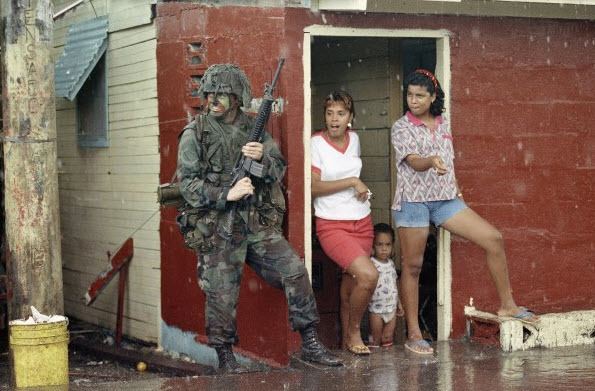 | ||
Similar Invasion of Grenada, Gulf War, Operation Acid Gambit, Operation Eagle Claw, Operation Enduring Freedom | ||
The United States Invasion of Panama, code named Operation Just Cause, was an invasion of Panama by the United States between mid-December 1989 and late January 1990. It occurred during the administration of President George H. W. Bush and ten years after the Torrijos–Carter Treaties were ratified to transfer control of the Panama Canal from the U.S. to Panama by 1 January 2000.
Contents
- Us invasion of panama 3 minute history
- Background
- United Statess justification for the invasion
- Invasion
- Noriegas capture
- Casualties
- Origin of the name Operation Just Cause
- Local and international reactions
- Aftermath
- Timeline
- Operations
- United States military forces involved in Operation Just Cause
- Related operations
- References

During the invasion, de facto Panamanian leader, general, and dictator Manuel Noriega was deposed, president-elect Guillermo Endara sworn into office, and the Panamanian Defense Force dissolved.
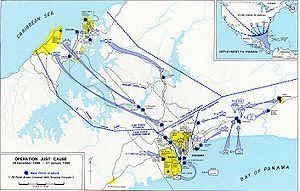
Us invasion of panama 3 minute history
Background
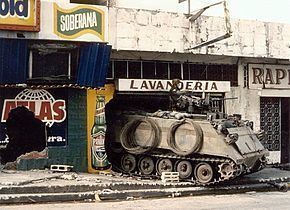
The United States long maintained numerous military bases and a substantial garrison throughout the Canal Zone to protect the American-owned Panama Canal and to maintain American control of this strategically important area. On 7 September 1977, President of the United States Jimmy Carter and the de facto leader of Panama, General Omar Torrijos, signed Torrijos–Carter Treaties, which set in motion the process of handing over the Panama Canal to Panamanian control by the year 2000. Although the canal was destined for Panamanian administration, the military bases remained and one condition of the transfer was that the canal would remain open for American shipping. The U.S. had long-standing relations with General Noriega, who served as a U.S. intelligence asset and paid informant of the Central Intelligence Agency from 1967, including the period when Bush was head of the CIA (1976–77).
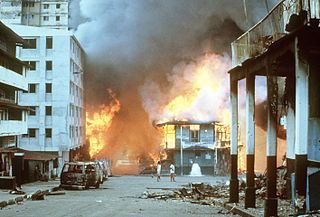
Noriega had sided with the U.S. rather than the USSR in Central America, notably in sabotaging the forces of the Sandinista government in Nicaragua, and the revolutionaries of the FMLN group in El Salvador. Noriega received upwards of $100,000 per year from the 1960s until the 1980s, when his salary was increased to $200,000 per year. Although he worked with the Drug Enforcement Administration to restrict illegal drug shipments, he was known to simultaneously accept significant financial support from drug dealers, because he facilitated the laundering of drug money, and through Noriega, they received protection from DEA investigations due to his special relationship with the CIA.

In the mid-1980s, relations between Noriega and the United States began to deteriorate. In 1986, U.S. President Ronald Reagan opened negotiations with General Noriega, requesting that the Panamanian leader step down after he was publicly exposed in The New York Times by Seymour Hersh, and later exposed in the Iran-Contra Scandal. Reagan pressured him with several drug-related indictments in U.S. courts; however, since extradition laws between Panama and the U.S. were weak, Noriega deemed this threat not credible and did not submit to Reagan's demands. In 1988, Elliot Abrams and others in the Pentagon began pushing for a U.S. invasion, but Reagan refused, due to Bush's ties to Noriega through his previous positions in the CIA and the Task Force on Drugs, and their potentially negative impact on Bush's presidential campaign. Later negotiations involved dropping the drug-trafficking indictments. In March 1988, Noriega's forces resisted an attempted coup against the government of Panama. As relations continued to deteriorate, Noriega appeared to shift his Cold War allegiance towards the Soviet bloc, soliciting and receiving military aid from Cuba, Nicaragua, and Libya. American military planners began preparing contingency plans to invade Panama.
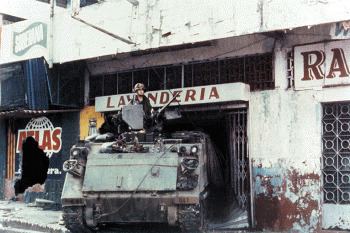
In May 1989, during the Panamanian national elections, an alliance of parties opposed to the Noriega dictatorship counted results from the country's election precincts, before they were sent to the district centers. Their tally showed their candidate, Guillermo Endara, defeating Carlos Duque, candidate of a pro-Noriega coalition, by nearly 3–1. Endara was beaten up by Noriega supporters the next day in his motorcade. Noriega declared the election null and maintained power by force, making him unpopular among Panamanians. Noriega's government insisted that it had won the presidential election and that irregularities had been on the part of U.S.-backed candidates from opposition parties. Bush called on Noriega to honor the will of the Panamanian people. The United States reinforced its Canal Zone garrison, and increased the tempo of training and other activities intended to put pressure on Noriega.
In October 1989, Noriega foiled a second coup attempt by members of the Panamanian Defense Forces (PDF), led by Major Moisés Giroldi. Pressure mounted on Bush as the media labeled him a "wimp" for failing to aid Panama, in spite of campaign rhetoric that called for a tough stand against drug traffickers. Bush declared that the U.S. would not negotiate with a drug trafficker and denied knowledge of Noriega's involvement with the drug trade prior to his February 1988 indictment, although Bush had met with Noriega while Director of the CIA and had been the Chair of the Task Force on Drugs while Vice President. On 15 December, the Panamanian general assembly passed a resolution declaring that the actions of the United States had caused a state of war to exist between Panama and the United States.
The next day, four U.S. military personnel were stopped at a roadblock around 9:00 PM outside PDF headquarters in the El Chorrillo neighborhood of Panama City. Marine Captain Richard E. Hadded, Navy Lieutenant Michael J. Wilson, Army Captain Barry L. Rainwater, and Marine First Lieutenant Robert Paz had left the Fort Clayton military base and were on their way to have dinner at the Marriott Hotel in downtown Panama City. The U.S. Department of Defense reported that the servicemen had been unarmed, in a private vehicle and that they attempted to flee only after their vehicle was surrounded by an angry crowd of civilians and PDF troops. The PDF asserted later that the Americans were armed and on a reconnaissance mission. The PDF opened fire and Lieutenant Paz was fatally wounded by a round that entered the rear of the vehicle and struck him in the back. Captain Hadded, the driver of the vehicle, was also wounded in the foot. Paz was rushed to Gorgas Army Hospital but died of his wounds. He received the Purple Heart posthumously. According to U.S. military sources, a U.S. Naval officer and his wife witnessed the incident and were detained by Panamanian Defense Force soldiers. While in police custody, they were assaulted by the PDF. The U.S. Naval officer spent two weeks in hospital recovering from the beating. PDF soldiers sexually threatened his wife. The next day, President Bush ordered the execution of the Panama invasion plan; the military set H-Hour as 0100 on 20 December.
United States's justification for the invasion
The official U.S. justification for the invasion was articulated by President George H. W. Bush on the morning of 20 December 1989, a few hours after the start of the operation. Bush listed four reasons for the invasion:
U.S. military forces were instructed to begin maneuvers and activities within the restrictions of the Torrijos-Carter Treaties, such as ignoring PDF roadblocks and conducting short-notice "Category Three" military exercises on security-sensitive targets, with the express goal of provoking PDF soldiers. U.S. SOUTHCOM kept a list of abuses against U.S. servicemen and civilians by the PDF while the orders to incite PDF soldiers were in place. As for the Panamanian legislature's declaration of a state of war between the U.S. and Panama, Noriega insists that this statement referred to a state of war directed by the U.S. against Panama, in the form of what he claimed were harsh economic sanctions and constant, provocative military maneuvers (Operations Purple Storm and Sand Flea) that were prohibited by the Torrijos-Carter Treaties. The U.S. had turned a blind eye to Noriega's involvement in drug trafficking since the 1970s. Noriega was then singled out for direct involvement in these drug trafficking operations due to the widespread public knowledge of his involvement in money laundering, drug activities, political murder, and human rights abuses.
Bush's four reasons for the invasion provided sufficient justification to establish bipartisan Congressional approval and support for the invasion. However, the secrecy before initiation, the speed and success of the invasion itself, and U.S. public support for it (80% public approval) did not allow Democrats to object to Bush's decision to use military force. One contemporary study suggests that Bush decided to invade for domestic political reasons, citing scarce strategic reasoning for the U.S. to invade and immediate withdrawal without establishing the structure to enforce the interests that Bush used to justify the invasion.
Two days before the invasion, on 18 December, Panama announced that the U.S. was planning an invasion of Panama.
Invasion
The U.S. Army, Air Force, Navy, and Marines participated in Operation Just Cause. Ground forces consisted of :
Air logistic support was provided by the 22nd Air Force with air assets from the 60th, 62nd, and 63rd military airlift wings.
The military incursion into Panama began on 20 December 1989, at 1:00 a.m. local time. The operation involved 27,684 U.S. troops and over 300 aircraft, including C-130 Hercules tactical transports flown by the 317th Tactical Airlift Wing (which was equipped with the Adverse Weather Aerial Delivery System or AWADS) and 314th Tactical Airlift Wing, AC-130 Spectre gunship, OA-37B Dragonfly observation and attack aircraft, C-141 Starlifter and C-5 Galaxy strategic transports, F-117A Nighthawk stealth aircraft flown by the 37th Tactical Fighter Wing, and AH-64 Apache attack helicopter. The invasion of Panama was the first combat deployment for the AH-64, the HMMWV, and the F-117A. Panamanian radar units were jammed by two EF-111As of the 390th ECS, 366th TFW. These aircraft were deployed against the 16,000 members of the PDF.
The operation began with an assault of strategic installations, such as the civilian Punta Paitilla Airport in Panama City and a PDF garrison and airfield at Rio Hato, where Noriega also maintained a residence. U.S. Navy SEALs destroyed Noriega's private jet and a Panamanian gunboat. A Panamanian ambush killed four SEALs and wounded nine. Other military command centers throughout the country were also attacked. The attack on the central headquarters of the PDF (referred to as La Comandancia) touched off several fires, one of which destroyed most of the adjoining and heavily populated El Chorrillo neighborhood in downtown Panama City. During the firefight at the Comandancia, the PDF downed two special operations helicopters and forced one MH-6 Little Bird to crash-land in the Panama Canal. The opening round of attacks in Panama City also included a special operations raid on the Carcel Modelo prison (known as Operation Acid Gambit) to free Kurt Muse, a US citizen convicted of espionage by Noriega.
Fort Amador was secured by elements of the 1st Battalion (Airborne), 508th Parachute Infantry Regiment, and 59th Engineer Company (sappers) in a nighttime air assault which secured the fort in the early hours of 20 December. Fort Amador was a key position because of its relationship to the large oil farms adjacent to the canal, the Bridge of the Americas over the canal, and the Pacific entrance to the Panama Canal. Key command and control elements of the PDF were stationed there. C Company 1st Battalion (Airborne) 508th PIR was assigned the task of securing La Comandancia. Furthermore, Fort Amador had a large U.S. housing district that needed to be secured to prevent the PDF from taking U.S. citizens as hostages. This position also protected the left flank of the attack on La Comandancia and the securing of the El Chorrillos neighbourhood, guarded by Dignity Battalions, Noriega supporters that the U.S. forces sometimes referred to as "Dingbats".
A few hours after the invasion began, Guillermo Endara was sworn in at Fort Clayton. According to The Los Angeles Times, Endara was the "presumed winner" in the presidential election which had been scheduled earlier that year.
A platoon from the 1138th Military Police Company, Missouri Army National Guard, which was on a routine two-week rotation to Panama was called upon to set up a detainee camp on Empire Range to handle the mass of civilian and military detainees. This unit was the first National Guard unit called into active service since the Vietnam War.
Noriega's capture
Operation Nifty Package was an operation launched by Navy SEALs to prevent Noriega's escape. They sank Noriega's boat and destroyed his jet, at a cost of four killed and nine wounded. Military operations continued for several weeks, mainly against military units of the Panamanian army. Noriega remained at large for several days, but realizing he had few options in the face of a massive manhunt and a $1 million reward for his capture, he obtained refuge in the Vatican diplomatic mission in Panama City. The U.S. military's psychological pressure on him and diplomatic pressure on the Vatican mission, however, was relentless, as was the playing of loud rock-and-roll music day and night in a densely populated area. The report of the Office of the Chairman of the Joint Chiefs of Staff maintains that the music was used principally to prevent parabolic microphones from being used to eavesdrop on negotiations, and not as a psychological weapon based around Noriega's supposed loathing of rock music. Noriega finally surrendered to the U.S. military on 3 January 1990. He was immediately put on an MC-130E Combat Talon I aircraft and flown to the U.S.
Casualties
According to official Pentagon figures, 516 Panamanians were killed during the invasion; however, an internal U.S. Army memo estimated the number at 1,000.
The UN estimated 500 deaths whereas Americas Watch found that around 300 civilians died. President Guillermo Endara said that "less than 600 Panamanians" died during the entire invasion.
Twenty-three U.S. servicemembers were killed and 325 were wounded. But in June 1990, the U.S. military announced that of the casualties, 2 dead and 19 wounded were victims of friendly fire. The U.S. Southern Command, then based on Quarry Heights in Panama, estimated the number of Panamanian military dead at 205, lower than its original estimate of 314.
Civilian fatalities included two American school teachers working in Panama for the Department of Defense Schools. They were Kandi Helin and Ray Dragseth. Rick Paul, the adult son of another teacher was also killed by friendly fire as he ran an American road block. Also killed was a Spanish freelance press photographer on assignment for El Pais, Juan Antonio Rodriguez Moreno. Rodriguez was killed outside of the Marriott Hotel in Panama City early on December 21. In June 1990, his family filed a claim for wrongful death against the United States Government. When the Rodriguez claim was rejected by the US government, in 1992 the Spanish government sent a Note Verbale extending diplomatic protection to Rodriguez and demanding compensation on behalf of his family. However, the US government again rejected the claim, disputing both its liability for warzone deaths in general and whether Rodriguez had been killed by US rather than Panamanian gunfire.
Human Rights Watch's 1991 report on Panama in the post-invasion aftermath stated that even with some uncertainties about the scale of civilian casualties, the figures are "still troublesome" because
[Panama's civilian deaths] reveal that the "surgical operation" by American forces inflicted a toll in civilian lives that was at least four-and-a-half times higher than military casualties in the enemy, and twelve or thirteen times higher than the casualties suffered by U.S. troops. By themselves, these ratios suggest that the rule of proportionality and the duty to minimize harm to civilians, where doing so would not compromise a legitimate military objective, were not faithfully observed by the invading U.S. forces. For us, the controversy over the number of civilian casualties should not obscure the important debate on the manner in which those people died.
The Commission for the Defense of Human Rights in Central America (CODEHUCA) estimated 2,500–3,000 deaths, and the Commission for the Defense of Human Rights in Panama (Comisión Nacional de Derechos Humanos de Panamá, CONADEHUPA) estimated 3,500 deaths.
Origin of the name "Operation Just Cause"
Operation plans directed against Panama evolved from plans designed to defend the Panama Canal. They became more aggressive as the situation between the two nations deteriorated. The Prayer Book series of plans included rehearsals for a possible clash (Operation Purple Storm) and missions to secure U.S. sites (Operation Bushmaster).
Eventually, these plans became Operation Blue Spoon which was then, in order to sustain the perceived legitimacy of the invasion throughout the operation, renamed by The Pentagon to Operation Just Cause. General Colin Powell said that he liked the name because "even our severest critics would have to utter 'Just Cause' while denouncing us."
The post-invasion civil-military operation designed to stabilize the situation, support the U.S.-installed government, and restore basic services was originally planned as "Operation Blind Logic", but was renamed "Operation Promote Liberty" by the Pentagon on the eve of the invasion.
The original operation, in which U.S. troops were deployed to Panama in early 1989, was called "Operation Nimrod Dancer".
Local and international reactions
The invasion of Panama provoked international outrage. Some countries charged that the U.S. had committed an act of aggression by invading Panama and was trying to conceal a new manifestation of its interventionist policy of force in Latin America. On 29 December, the General Assembly of the United Nations voted 75–20, with 40 abstentions, to condemn the invasion as a flagrant violation of international law.
On 22 December, the Organization of American States passed a resolution deploring the invasion and calling for withdrawal of U.S. troops, as well as a resolution condemning the violation of the diplomatic status of the Nicaraguan Embassy in Panama by U.S. Special Forces who had entered the building. At the UN Security Council, after discussing the issue over several days, a draft resolution demanding the immediate withdrawal of U.S. forces from Panama was vetoed on 23 December by three of the permanent members of the Security Council, France, United Kingdom, and the United States, who cited its right of self-defense of 35,000 Americans present on the Panama Canal.
Peru recalled its ambassador from the U.S. in protest of the invasion.
Some claim that the Panamanian people overwhelmingly supported the invasion. According to a CBS poll, 92% of Panamanian adults supported the U.S. incursion, and 76% wished that U.S. forces had invaded in October during the coup. However, others dispute this finding, asserting that the Panamanian surveys were conducted in wealthy, English-speaking neighborhoods in Panama City, among Panamanians most likely to support U.S. actions. Human Rights Watch described the reaction of the civilian population to the invasion as "generally sympathetic". According to Robert Pastor, a former U.S. national security advisor, 74% of Americans polled approved of the action.
In 2006, one author opined that "President Bush had not defended the hemisphere against European aggression under the guise of the Monroe Doctrine, or used the threat of Communist proliferation to take action, but instead he had used the US military to remove a hostile and problematic Latin American dictator from power because it was in the best interests of the United States to do so."
Eighteen years after the invasion, Panama's National Assembly unanimously declared 20 December 2007 to be a day of national mourning. The resolution was vetoed by President Martin Torrijos.
The Washington Post disclosed several rulings of the Office of Legal Counsel, issued shortly before the invasion, in regards to the U.S. armed forces being charged with making an arrest abroad. One ruling interpreted an executive order which prohibits the assassination of foreign leaders as suggesting that accidental killings would be acceptable foreign policy. Another ruling concluded that the Posse Comitatus Act of 1878, which prohibits the armed forces from making arrests without Congressional authorization, is effective only within the boundaries of the U.S., such that the military could be used as a police force abroad—for example, in Panama, to enforce a federal court warrant against Noriega.
Aftermath
Guillermo Endara, in hiding, was sworn in as president by a judge on the night preceding the invasion. In later years, he staged a hunger strike, calling attention to the poverty and homelessness left in the wake of both the Noriega years and the destruction caused by the U.S. invasion.
On 19 July 1990, a group of 60 companies based in Panama filed a lawsuit against the U.S. government in Federal District Court in New York City alleging that the U.S. action against Panama was "done in a tortuous, careless and negligent manner with disregard for the property of innocent Panamanian residents". Most of the businesses had insurance, but the insurers either went bankrupt or refused to pay, claiming that acts of war were not covered.
About 20,000 people lost their homes and became refugees as a result of urban warfare. About 2,700 families that were displaced by the Chorrillo fire were each given $6,500 by the U.S. to build a new house or apartment in selected areas in or near the city. However, numerous problems were reported with the new constructions just two years after the invasion.
The government of Guillermo Endara designated the first anniversary of the U.S. invasion a "national day of reflection". On that day hundreds of Panamanians marked the day with a "black march" through the streets of Panama City to denounce the U.S. invasion and Endara's economic policies. Protesters echoed claims that 3,000 people were killed as a result of U.S. military action. Since Noriega's ousting, Panama has had four presidential elections, with candidates from opposing parties succeeding each other in the Palacio de las Garzas. Panama's press, however, is still subject to numerous restrictions. On 10 February 1990, the Endara government abolished Panama's military and reformed the security apparatus by creating the Panamanian Public Forces. In 1994, a constitutional amendment permanently abolished the military of Panama. Concurrent with a severe recession in Latin America throughout the 1990s, Panama's GDP recovered by 1993, but very high unemployment remained a serious problem.
Noriega was brought to the U.S. to stand trial. He was subsequently convicted on eight counts of drug trafficking, racketeering, and money laundering and sentenced to 40 years in prison. His sentence was later reduced to 30 years.
On December 20, 2015, Vice President Isabel De Saint Malo de Alvarado announced Panama's intention to form a special independent commission with the aim to publish a so-called "truth report" to mark the 26th anniversary of the US attack on Panama. The commission's goal would be to identify victims so that reparations could be paid to their families, as well as to establish public monuments and school curriculums to honor history and reclaim Panama's collective memory. Victims' families have claimed that theretofore investigations into the invasion had been funded by Washington and therefore were biased.
Timeline
Information in this section
September 1987
November 1987
February 1988
March 1988
April 1988
May 1989
June–September 1989 (Operation Nimrod Dancer)
October 1989 (Operation Nimrod Dancer)
December 1989
D-Day, 20 December 1989
3 January 1990 (D-Day + 14)
31 January 1990 (D-Day + 42)
September 1994 (D-Day + approximately 4.5 years)
Operations
All 27 objectives related to the Panamanian Defense Force were completed on D-Day, 20 December 1989. As initial forces moved to new objectives, follow-on forces from the 7th Infantry Division (L) moved into the western areas of Panama and into Panama City.
19 December 1989 (D-Day − 1)
20 December 1989 (D-Day)
21 December 1989 (D-Day + 1)
22 December 1989 (D-Day + 2)
23 December 1989 (D-Day + 3)
24 December 1989 (D-Day + 4)
25 December 1989 (D-Day + 5)
3 January 1990 (D-Day + 14)
31 January 1990 (D-Day + 42)
September 1994 (D-Day + approximately 4.5 years)
Above information in this section
United States military forces involved in Operation Just Cause
United States Southern Command
United States Marine Corps
United States Special Operations Command
United States Air Force
United States Navy
